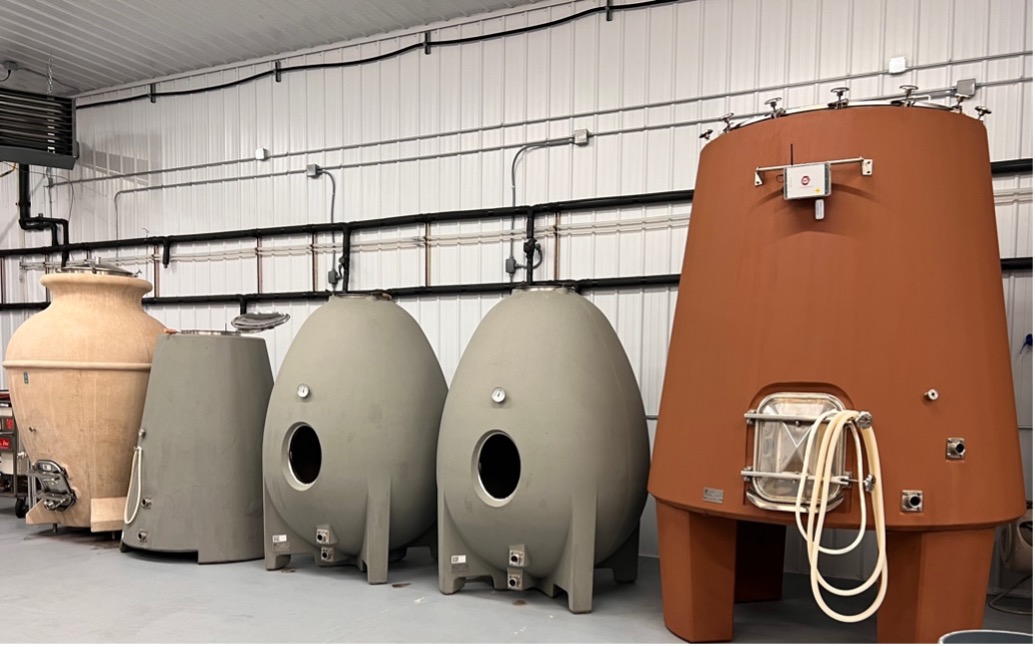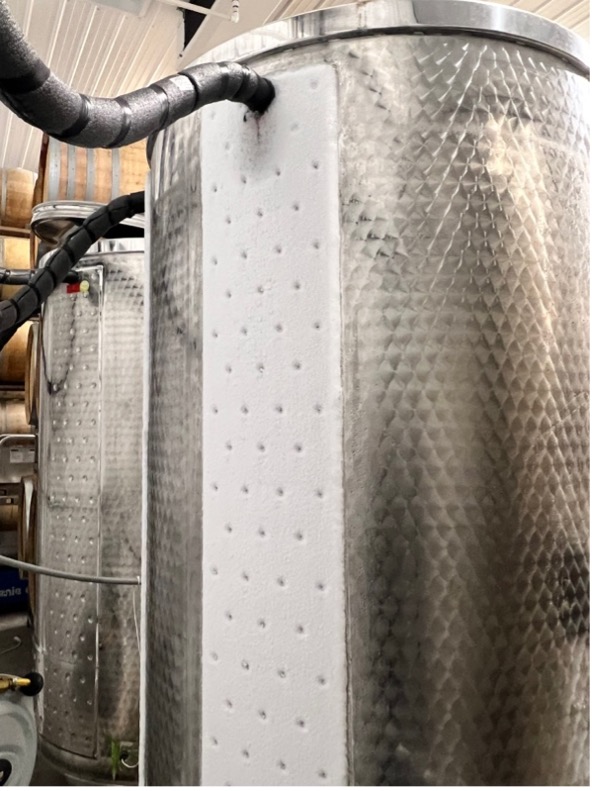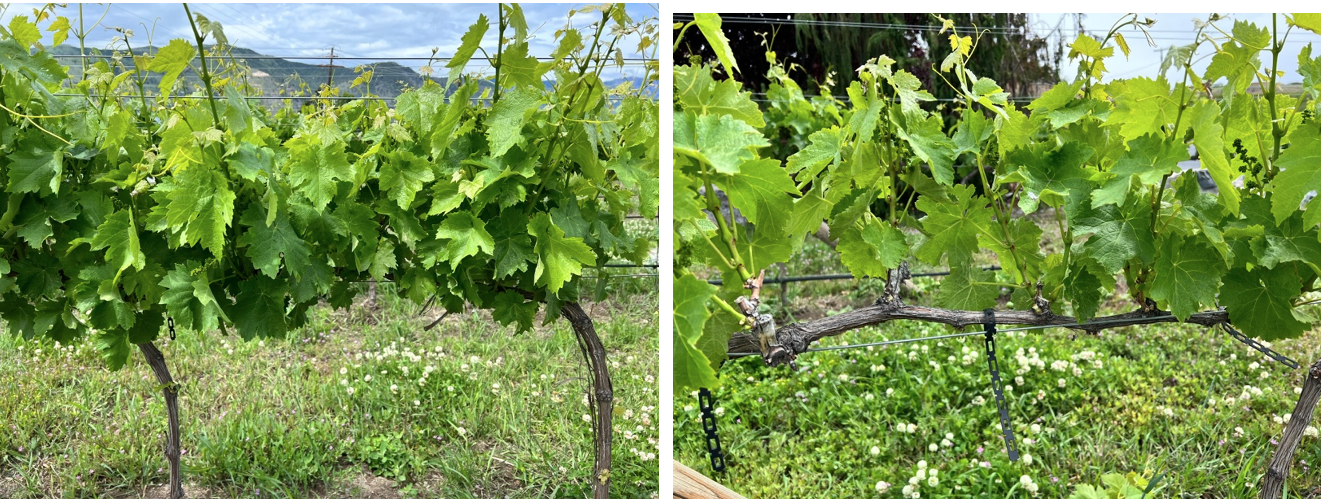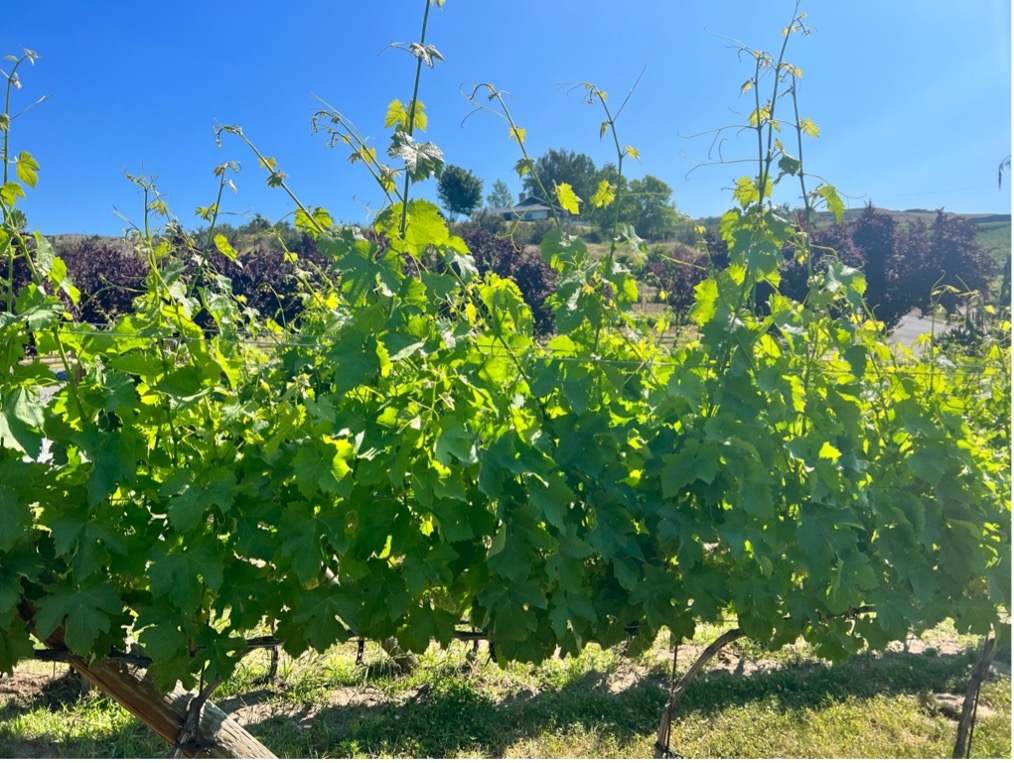The fourth story from Miriah Falce, Enologist at Cairdeas Winery in the Lake Chelan AVA.
Finally some heat!
June continued at the same pace as May, cool temps and more rain, with the awaiting of bloom. The last week and a half of June we FINALLY cracked 80 for the first time. We had one hot weekend over 90 but for the most part have been staying in the mid 80s and sunny which is ideal for growing.
Winery Summary:
We started out the month with our Estate Wine Club dinner. Seven seafood courses paired with our three estate wines: Sparkling Clairette Blanche, Picardan, and Syrah. I loved getting to share the 2021 Picardan I helped make and socialize with our amazing friends and members.

We’ve been attending a lot of learning experiences over the past few months to help increase our knowledge and skills–Charlie and I attended a barrel event to go over toasting/cooperages and learned how to take apart and put them back together. I was also on the planning committee for Washington Wine Tech Group’s summer seminar which was a day of vineyard and wine discussion.
Fellow ambassador Nic Stevens and I went on the local radio to talk about the Breaking Ground program which was lots of fun! Also spent an afternoon with him at Tsillian Cellars for “market research” tasting through all of their fabulous whites.

The winemaking is pretty slow this time of year, as most everything has been bottled and we’re starting to prep for harvest. We have a few small lots for our upcoming August bottling and that’ll be it for botting this year! We kept two whites back, Marsanne in our concrete egg and Roussanne in oak, to give us a couple more whites to get us through the summer and we also have our concrete Grenache and Syrah. Along with getting some new tanks, we’ve been working on the last details to get whites ready for bottle.

Low intervention winemaking has always been the style I have looked up to and followed. It’s why I love working at a place that has that same ideology and why I love Washington wines, the majority of which are small or family owned which to me makes a huge difference in final product compared to bulk national labels. Ideally we leave our reds unfined and unfiltered, while on our whites we will do very minor fining and crossflowing.
Cold stability: whose heard of the phrase “wine diamonds”? Also known as tartrates, they are a completely normal product in the winemaking process that occurs because of naturally found tartaric acid (there’s tons of different acids and molecules in wine) that precipitates out. In fact, it’s the exact same as cream of tartar that can be found in grocery stores. However, most consumers don’t want crystals in their white wine when they pull it out of the fridge so many places cold stabilize. One way of doing it is known as ‘seeding’, where cream of tartar is added to the tank and chilled to 32 degrees for a few weeks. Crystals conglomerate together, so the addition of KHT creates nucleation sites for that to occur. At Cairdeas, we chill our tanks and do not seed, letting the precipitation happen on it’s own. The tartrates settle out and are not in the finished wine. Wine is cold stable for as long as and as cold as they were stabilized for.

Heat stability: In order to prevent protein instability and limit cloudiness when your bottle gets warm, an extremely common practice is adding natural bentonite clay. Protein hazes cannot be tasted and are simply an aesthetic, but again consumers like clear wine so most wineries do this. Bentonite’s negative charge binds with the positively charged proteins floating around and everything settles to the bottom. The wine is cleanly racked off the sediment (think of two distinct layers like water on top of sand), none of the clay remains, and you have your clear wine!
Vineyard Summary:
At the beginning of the month we finished suckering, which is the removal of extra shoots at the base and trunk of the vine. We then began shoot thinning which removes extra shoots to allow for better ripening/vine balance, and also creates space between shoots for airflow. Cultural practices like that plus elemental sulphur sprays work together in the fight against powdery mildew. With all the rain and cooler temps we had, the risk of mildew was increased (compared to the heat dome last year) so airflow and our breezy Chelan afternoons help dry out the canopies of any moisture. Elemental sulphur works as a contact against fungal spores that may be present, which wake up in a rain event.

By removing extra shoots and taking the spurs down to 2 shoots each, we help the plant focus on ripening fewer clusters by not expending extra energy on anything unnecessary. Because we pick our Clairette at low sugar and high acidity, we do not shoot thin as accumulating high sugars is not as important. Even since shoot thinning at the beginning of the month, we’ve had so much canopy growth!

On June 20th we finally had bloom! Almost exactly three weeks behind last year. That was also when temps finally got above 80 so now we just hope that the heat stays on all summer! European grape vines/Vitis vinifera are self-pollinating so unlike apples, cherries, flowers, etc they do not need pollination from bees. The clusters start to elongate and separate out, and then each individual inflorescence begins to push it’s cap off, where a flower lies underneath. Each individual flower contains an ovary, and little anthers sticking off produce the pollen which falls and fertilizes. Over the next week and by the end of the month, we achieved full bloom across the vineyard.

As of June 26 lake Chelan was at 506 GDD. Same date in 2021 we were at 953, and in 2011 we were at 474. So starting to slightly pull ahead this year!

Traducido por Rosanna Lugo.
Finalmente algo de calor!
Junio continuó al mismo paso que mayo, temperaturas frescas y más lluvia, con la espera de la floración. La última semana y media de junio por fin llegamos a los 80 grados por primera vez. Tuvimos un solo fin de semana que estuvo sobre los 90 grados pero en su mayoría ha estado en los 80´s, soleado, condiciones ideales para el crecimiento.
Resumen de la vinícola:
Empezamos este mes con nuestra cena del club de vinos. Siete tiempos de cocina de mar maridados con tres vinos de nuestro viñedo: Clairette Blance espumante, Picardan, y Syrah. Me encantó compartir el Picardan 2021 que colaboré en su creación y también socializar con nuestros increíbles amigos y miembros.

Hemos estado atendiendo a varias experiencias de aprendizaje en los últimos meses para ayudar a incrementar nuestro conocimiento y habilidades—Charlie y yo fuimos a un evento tonelero en dónde aprendimos sobre el tostado y las distintas tonelerías y para aprender a desarmar y armar una barrica completa. A su vez fui parte del comité técnico para los vinos de Washington durante el seminario de verano que fue un día completo de discusiones sobre vinos y viñedos.
Mi amigo y también embajador Nic Stevens y yo fuimos a la radio local para hablar de Breaking Ground y fue muy divertido. A su vez pasé la tarde con él en Tsillan Cellars para hacer un sondeo de mercado probando todos sus vinos blancos que son deliciosos.

La enología va bastante lenta durante este momento del año, ya que todo lo hemos embotellado y nos estamos empezando a preparar para la vendimia. Tenemos sólo unos pequeños lotes para fraccionar en agosto y ya será todo por este año. Mantuvimos dos vinos blancos a granel, Marsanne, que fue hecho y añejado en el huevo de concreto y un Roussanne en barrica, para darnos un par de vinos blancos para el verano. A su vez tenemos nuestros Grenache y Syrah que fueron añejados en concreto. A la par de comprar algunos tanques nuevos, hemos estado trabajando en los últimos detalles para llevar los vinos blancos a botella.

La mínima intervención en la enología es el estilo con el que siempre me he identificado y seguido. Por tanto me encanta trabajar en un lugar que tiene la misma mentalidad y visión y por eso me encantan los vinos de Washington, la mayoría de los cuales son pequeños y empresas familiares, que para mi, hacen una gran diferencia en el producto final comparado con las empresas enormes nacionales que hacen vino a granel. Idealmente dejamos nuestros vinos tintos sin clarificar ni filtrar, a su vez con respecto a nuestros vinos blancos, hacemos una mínima clarificación y filtración.
Estabilización en frío: Quién ha escuchado la frase: diamantes vínicos? También llamados tartratos, son un producto normal en el proceso de hacer el vino que ocurre ya que el ácido tartárico (hay muchísimos ácidos y moléculas en el vino), precipita. De hecho, es la misma Crema tartárica que pueden encontrar en el supermercado. Sin embargo, la mayoría de los consumidores de vino no quieren esos cristales en sus vinos blancos cuándo los sacan del refrigerador, así que muchas vinícolas optan por estabilizar en frío. Una manera de hacerlo es aplicando crema tartárica al vino y reducir la temperatura a 32 grados por algunas semanas. Los cristales se unen, por tanto la adición de bitartrato de potasio crea sitios de nucleación para que eso ocurra. En Cairdeas, enfriamos nuestros tanques y pero no aplicamos crema tartárica dejando que la precipitación ocurra naturalmente. Los tartratos precipitan y desaparecen del vino final. El vino permanece estable por el tiempo y por la temperatura de la cual se estabilizó.

Estabilización de calor: Para prevenir inestabilidades proteicas y limitar la turbidez en un vino cuándo este se lleva a temperaturas superiores, una práctica muy común es añadir bentonita (arcilla). Las proteínas no tienen función sensorial y son simplemente un problema estético. Sin embargo, los consumidores quieren vinos limpios y diáfanos por tanto la mayoría de las vinícolas hacen esto. La carga negativa de la bentonita se une a la carga positiva de las proteínas que flotan y por tanto precipitan al fondo de la vasija o tanque. El vino se trasiega limpiamente del sedimento (visualicen dos capas como la de agua y arena), se remueve todo la arcilla, y tenemos vino limpio.
Resumen del viñedo:
Al inicio del mes terminamos la limpieza del tronco de las vides de toda materia en verde. Comenzamos a realizar el despampanado, que significa remover pámpanos extra de la canopia para mejorar la circulación y mejorar el balance. Las prácticas culturales cómo esta añadido a aplicaciones de azufre elemental trabajan en simbiosis contra el oídio. Con toda la precipitación y el clima templado que hemos tenido, el riesgo de plagas fúngicas incrementa (comparado con el calor del año pasado) así que la circulación en las tardes de nuestro Chelan ventoso ayuda a mantener nuestras canopias secas. El azufre elemental trabaja en contacto contra las esporas fúngicas que pudieran estar presentes, que en cualquier evento de precipitación se activan.

Al remover pámpanos extra y reducir los pulgares a dos pámpanos, ayudamos a la planta a enfocarse en madurar menos cantidad de racimos y así podemos conducir la energía a sólo lo necesario. Ya que cosechamos nuestro Clairette con azucares bajos y acidez alta, no despampanamos ya que la acumulación de azucares no es tan importante. Desde que despampanamos al inicio del mes hemos tenido muchísimo crecimiento de canopia.

El 20 de Junio por fin tuvimos floración, casi tres semanas atrasado comparado con el año anterior. A su vez fue cuándo las temperaturas finalmente ascendieron a más de 80 grados y ahora sólo nos queda esperar que el calor se mantenga todo el verano. La Vitis Vinifera es un flor perfecta, ósea que se poliniza sola así que a diferencia de los cerezos, manzanos o flores, estas no necesitan de las abejas. Los racimos comienzan a elongar y a separarse, y después cada inflorescencia comienza a tirar la capa, en dónde la flor se encuentra resguardada. Cada flor contiene un ovario, y pequeñas antenas que producen el polen que cae y fertiliza. En la próxima semana y hasta el fin de mes, habremos tenido floración al 100% por todo el viñedo.



Join the Conversation